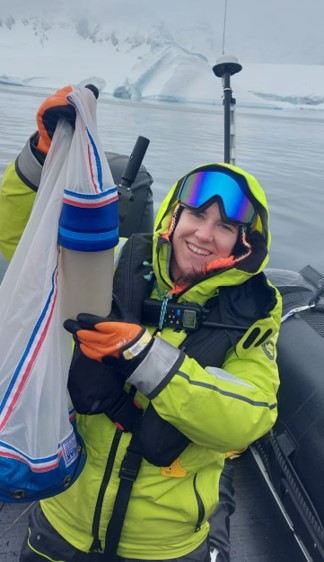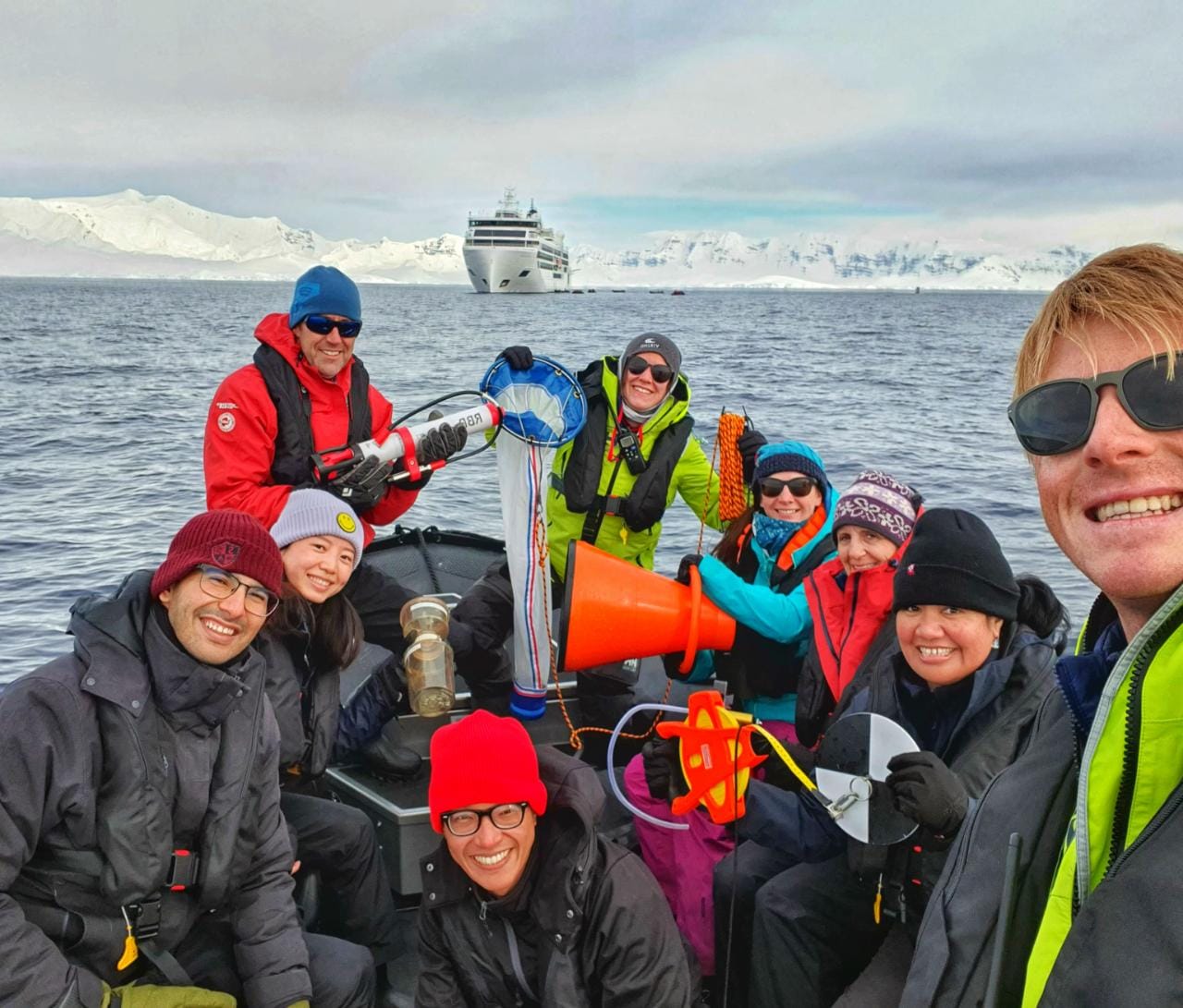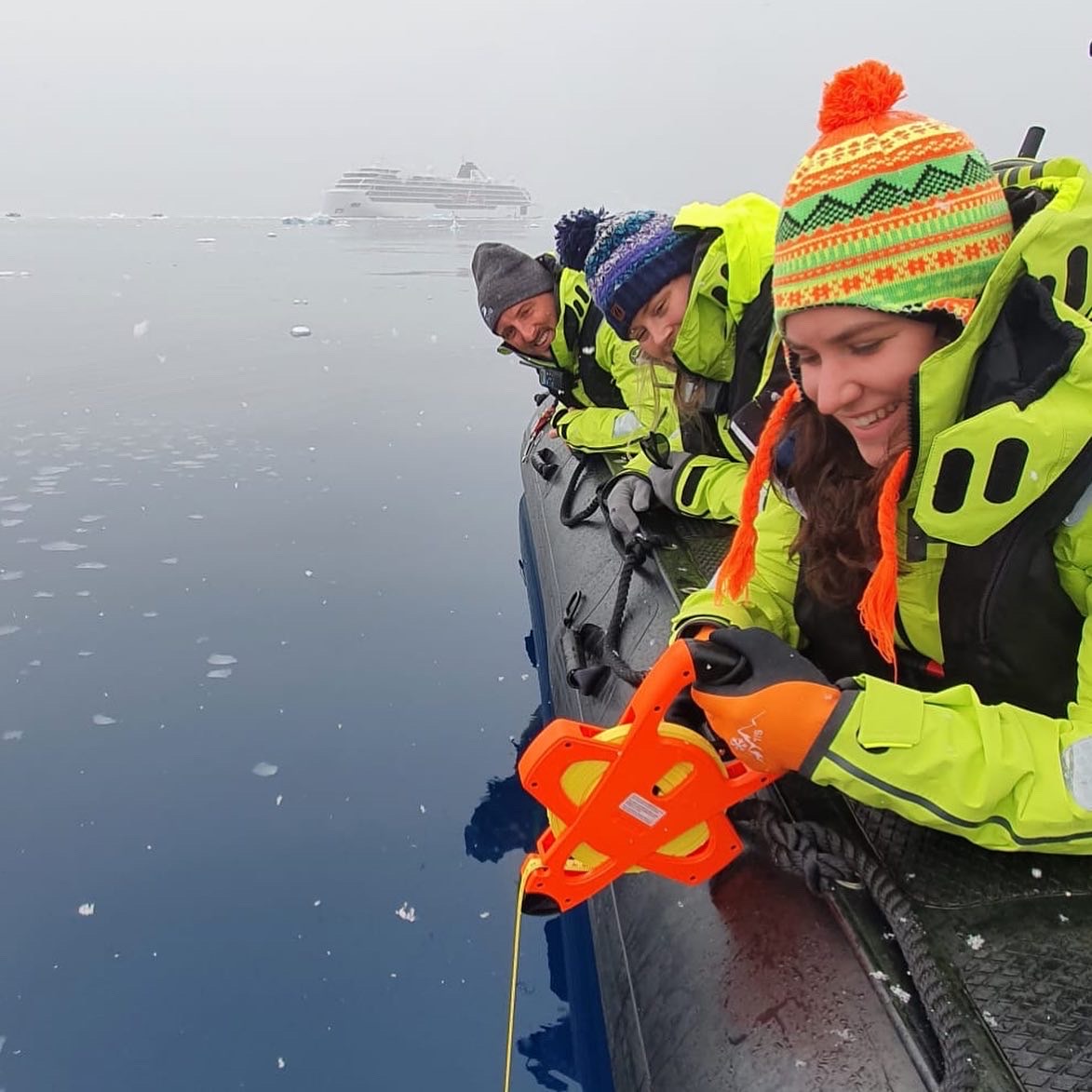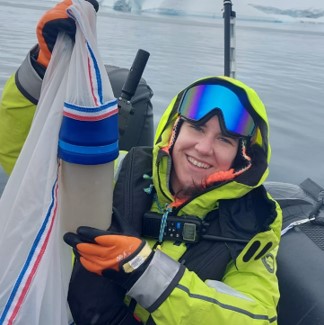Alumni News
From Alaska to Antarctica, Holly Kelchner explores the World’s Waterways
..
Holly Kelchner, 2020-2022 CIGLR Aquatic Ecology Research Analyst

Holly Kelchner holding up a full sample of filtered phytoplankton.
Holly Kelchner was an Aquatic Ecology Research Analyst for CIGLR from 2020-2022. Kelchner was an integral part of the harmful algal bloom (HAB) research team coordinating the Western Lake Erie monitoring cruises and leading toxin quantification through bioassay techniques.
While completing her master’s degree at Louisiana State University (LSU), Kelchner’s graduate advisor, Reagan Errera, PhD, joined the HAB monitoring team at NOAA GLERL, providing Kelchner the opportunity to relocate to Michigan. After graduating from LSU, Kelchner continued her collaboration with Dr. Errera and joined CIGLR as an Aquatic Ecology Research Analyst as the primary fieldwork coordinator for the HAB team. Throughout the fieldwork season, Kelchner prepared equipment for water collection on Lakes Erie and Huron and coordinated the team’s complex field schedules. Due to the dynamic nature of her position, no two days were alike. “One day, I might find myself conducting fieldwork on the water, while another I might be in the laboratory conducting toxin analysis or DNA extraction,” said Kelchner. “I would also take part in discussions about how HABs impact local communities, which brought my work face-to-face with the public.”
In the fall of 2022, Kelchner seized an opportunity to join Viking Expedition Cruises to Antarctica, becoming the Viking Polaris’s inaugural Field Scientist. “I collaborated with the Chief Scientist to oversee the ship’s science program,” said Kelchner. “I used my expertise in phytoplankton ecology to spearhead the polar citizen science initiative known as Fjord Phyto, a partnership with Scripps Institution of Oceanography (La Jolla, CA) and the Universidad Nacional de La Plata (Buenos Aires, Argentina), to collect phytoplankton samples from the Antarctic coast to monitor how melting glaciers influence phytoplankton populations. I was also in charge of several other operations that included launching weather balloons, deploying ROVs, gathering data through Baited Remote Underwater Video Surveillance (BRUVS), and conducting water quality analysis.”

Sampling for the Fjord Phyto initiative in Antarctica, November 2022.
“Despite the allure of working on a luxury cruise ship, the reality was demanding,” said Kelchner. “The workdays were long, often stretching beyond 12 hours, depending on where the ship was located and prevailing weather conditions.”
Nonetheless, Kelchner fondly recalls the highlight of her experience: the diverse team she collaborated with. “I had the pleasure of working with a team from various corners of the globe and representing diverse backgrounds,” said Kelchner. “I embraced the ethos that ‘everyone has something to teach you,’ a mindset that resonated throughout my six-month tenure in the Southern Ocean.”
Following several months of travel, Kelchner recently joined the Implementation Team at the Science Education Resource Center (SERC) at Carleton College in Northfield, MN. “At SERC, I utilize my wide array of science experience to connect educators from all over the country with resources and activities to enhance curriculum and implement systemic change.”
Q & A WITH HOLLY KELCHNER
Q: Which is your favorite Great Lake and why?
Lake Superior will always be superior to the other Great Lakes in my world. I grew up in Minnesota and spent countless nights camping along the north shores of Lake Superior, kayaking around the Apostle Islands in Wisconsin, and exploring the northern shores of Michigan’s Upper Peninsula. One of my most proud childhood moments was earning $50 on a dare to take the polar-like plunge in Lake Superior with all my clothes on. I was not prepared to swim in a 45°F lake!
Q: Where did you do your college/graduate work and what did you study?
I completed my undergraduate degree at the University of Alaska Southeast (UAS) in marine biology. UAS is located in Juneau, Alaska and gave me the opportunity to study the natural world in the natural environment. I don’t know of any other place in the country where I would get to learn about primary succession at a glacier or get an email from a professor asking if I wanted to help with an orca necropsy (after it had washed up on a nearby beach). The environment I had at UAS was the best place to get a hands-on education.

Holly using a secchi disk to measure water clarity in Fournier Bay in the Palmer Archipelago, Antarctic, with other members of the science team, Emily Cunningham and Dr. Daniel Moore.
I completed my Master of Science degree at Louisiana State University in Baton Rouge, LA where I primarily studied oceanography and coastal science. My master’s project centered on novel research exploring the harmful algal bloom and plankton ecology of coastal Mozambique, a southern African nation. Our study area was located near the remote beach town of Tofo, an area that is known for year-round sightings of whale sharks and manta rays (megafauna that eat plankton). This project was full of challenges due to its remote location and pioneering research questions. I definitely learned how to adapt quickly and how to be resourceful!
Q: What is your current position and what led you to pursue this career path?
I currently work for the Science Education Resource Center (SERC) at Carleton College in Northfield, MN. It was by chance that I found my current position. I was looking for a career change but didn’t necessarily know where to look. I wanted to remain working in the natural sciences but didn’t necessarily think that my experience in oceanography was too useful to bring back to Minnesota. But then I found the team at SERC and it has been incredibly rewarding, a positive reminder that it’s possible to find a great fit when you least expect it.
Q: Why were you interested in working at CIGLR?
When I was finished with my master’s degree in harmful algal bloom ecology, I saw the perfect opportunity to utilize my skills and return home to the Great Lakes region. By joining the CIGLR team, I was surrounded by incredible scientists from many different backgrounds and was able to bring my own specialized skills to our research group. It was fulfilling to be a part of such a critical research team, that helps protect and inform the local community and ecosystem health.
Q: What advice would you give to someone interested in an environmental science career?
I would say, “don’t be afraid to try something new.” You never know what you might learn about yourself or your interests along your life’s journey. Take advantage of opportunites, get out of your comfort zone, and learn something new. You never know what could be waiting for you.
Q: What was your favorite part about working at CIGLR?
My favorite part about working for CIGLR was the people. I loved the diversity of research and personal interests that the CIGLR team had. I was also always learning and discovering something new from one of CIGLR’s other research teams.
Related Articles and Resources:
..
-
- CIGLR staff member feels at home on the water, The University Record
- Kelchner, H.; K.E. Reeve-Arnold; K.M. Schreiner; S. Bargu; K.G. Roques; R.M. Errera. 2021. Domoic Acid and Pseudo-nitzschia spp. Connected to Coastal Upwelling along Coastal Inhambane Province, Mozambique: A New Area of Concern. Toxins. 13(12), 903. (DOI:3390/toxins13120903).
- Boegehold, A.G.; A.M. Burtner; A.C. Camilleri; G. Carter; P. DenUyl; D. Fanslow; D. Fyffe Semenyuk; C.M. Godwin; D. Gossiaux; T.H. Johengen; Kelchner; C. Kitchens; L.A. Mason; K. McCabe; D. Palladino; D. Stuart; H. Vanderploeg; R.M. Errera. 2023. Routine Monitoring of Western Lake Erie to Track Water Quality Changes Associated with Cyanobacterial Harmful Algal Blooms. Earth System Science Data. 15(8):3853–3868. (DOI:10.5194/essd-15-3853-2023).

